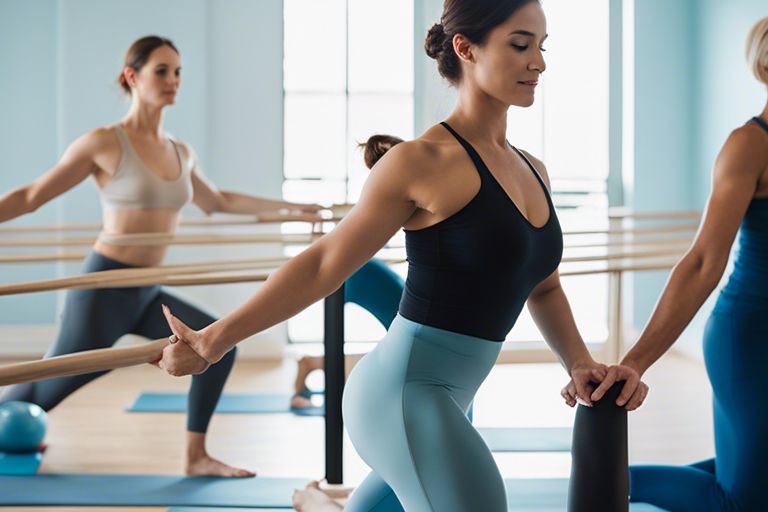Strengthening your core muscles and improving flexibility through Pilates can have a profound impact on your posture. Good posture not only enhances your appearance but also plays a crucial role in preventing back pain and injury. By incorporating specific strengthening and stretching exercises into your routine, you can begin to correct postural imbalances and develop a stronger, more balanced body. In this blog post, we will investigate into the world of Pilates for posture, exploring techniques that can help you achieve a more upright and aligned stance for overall improved well-being.
Key Takeaways:
- Pilates can help improve posture: Pilates focuses on strengthening the core muscles that support good posture, leading to better alignment of the spine and overall posture.
- Combination of strengthening and stretching: Pilates incorporates both strengthening and stretching exercises, helping to lengthen tight muscles and strengthen weak muscles for improved posture.
- Focus on alignment and body awareness: Pilates emphasizes proper alignment and body awareness, which can help individuals become more mindful of their posture in everyday activities.
- Improved muscle balance: Pilates helps to create a balance between muscle groups, which is important for maintaining good posture and preventing musculoskeletal imbalances.
- Long-term benefits: Practicing Pilates regularly can lead to long-term improvements in posture, as well as increased strength, flexibility, and overall well-being.
The Science of Posture
While many may view good posture as simply sitting or standing up straight, the science behind posture is far more complex and fascinating. Posture is not just about how we look; it is a reflection of how well our musculoskeletal system supports and aligns our body. Understanding the science of posture can lead to significant improvements in overall health and well-being.
Anatomical Insights on Spinal Alignment
Anatomical science plays a crucial role in understanding the nuances of spinal alignment and how it impacts posture. The spine is not just a straight line but a series of curves that act as shock absorbers, providing flexibility, and support. The proper alignment of these curves is crucial for maintaining good posture and preventing issues such as back pain and muscle strain.
The vertebrae, intervertebral discs, muscles, and ligaments all play integral roles in supporting the spine and maintaining proper alignment. Weakness or imbalance in any of these components can lead to postural imbalances and discomfort. Pilates exercises focus on strengthening these supporting structures to promote better posture and spinal alignment.
The Role of Musculoskeletal Health in Posture
Role The musculoskeletal system, which includes muscles, bones, tendons, and ligaments, is at the core of maintaining good posture. Strong, flexible muscles provide the necessary support to keep the spine aligned and the body upright. When these muscles are weak or tight, it can lead to postural issues such as slouching or rounded shoulders.
Insights Pilates for Posture not only helps strengthen the muscles that support good posture but also promotes flexibility, balance, and overall musculoskeletal health. By engaging in Pilates exercises regularly, individuals can improve their posture, increase mobility, and reduce the risk of injuries related to poor alignment.

Pilates Methodology for Postural Improvement
Keep your focus on the fundamental principles of the Pilates method to achieve significant improvements in your posture. Through a combination of controlled movements, conscious breathing, and mental focus, Pilates offers a holistic approach to strengthening and stretching the body for better alignment and balance.
Core Strengthening Exercises
Strengthening the core muscles is key to improving posture and stability. Pilates emphasizes exercises that target the deep muscles of the abdomen, pelvis, and lower back, helping to support the spine and maintain proper alignment. Movements such as the Hundred, Plank, and Teaser engage the core effectively, building strength and endurance for better posture.
By consistently practicing core strengthening exercises in Pilates, you can develop a strong foundation that supports the rest of your body and reduces the risk of postural imbalances and pain. Focus on precision and control in each movement to maximize the benefits for your core muscles and overall posture.
Flexibility and Stretching Routines
Pilates also incorporates a variety of flexibility and stretching routines that complement the core strengthening exercises. These movements help to lengthen and elongate the muscles, enhancing mobility and range of motion in the joints. Exercises like the Swan Dive, Mermaid, and Spine Stretch Forward promote flexibility in the spine, shoulders, and hips.
Flexibility is crucial for maintaining good posture and preventing injury. By regularly practicing Pilates stretching routines, you can improve your overall flexibility, reduce muscle tension, and enhance your body’s ability to move with fluidity and ease. Focus on breathing deeply and mindfully as you stretch to enhance the relaxation response in your body.
Optimizing Your Pilates Practice
Unlike other forms of exercise, Pilates offers a unique approach to improving posture through a combination of strengthening and stretching techniques. To get the most out of your Pilates practice, it’s vital to tailor exercises to your individual needs and integrate mindfulness and control into your movements.
Tailoring Exercises to Individual Needs
Needs can vary widely when it comes to improving posture. Some individuals may have tight hip flexors that contribute to a hunched posture, while others may have weak back muscles that lead to slouching. By customizing Pilates exercises to target specific areas of weakness or tightness, you can address your individual needs and make significant improvements in your posture over time.
Integration of Mindfulness and Control
Exercises in Pilates focus on precise movements that require mindfulness and control to execute correctly. By engaging your mind and body in each movement, you can develop a deeper awareness of your posture and alignment. This mind-body connection not only improves your physical strength and flexibility but also enhances your overall posture and body awareness.
Individuals who embrace the integration of mindfulness and control in their Pilates practice often experience a greater sense of body awareness and alignment. By focusing on the quality of each movement and maintaining proper alignment throughout the exercises, you can enhance the benefits of Pilates for improving your posture and overall well-being.

The Impact of Regular Pilates
Many individuals who commit to a regular Pilates practice experience significant improvements in their posture, strength, flexibility, and overall well-being. The consistent focus on core strength and alignment in Pilates exercises helps to correct muscle imbalances and poor postural habits that may have developed over time. As a result, participants often notice a more upright stance, reduced back pain, and improved body awareness.
Evaluating Progress and Postural Changes
For those dedicated to their Pilates routine, tracking progress and observing postural changes can be a rewarding experience. By keeping a journal or working with a Pilates instructor, individuals can document improvements in their alignment, muscle tone, and range of motion. Regular practice of Pilates can lead to enhanced posture, increased stability, and a greater sense of confidence in one’s body.
Additionally, as practitioners become more mindful of their movements during Pilates sessions, they can carry those principles into their daily activities. This increased awareness of posture and alignment can prevent future injuries and alleviate chronic discomfort, contributing to a healthier and more active lifestyle.
Long-term Health Benefits for the Body and Mind
Health benefits of Pilates extend beyond physical improvements to encompass mental well-being as well. Regular practice of Pilates has been associated with reduced stress levels, increased relaxation, and improved mental clarity. The mind-body connection cultivated through Pilates can lead to a more balanced and resilient psyche.
Impact on mental health is an imperative aspect of long-term Pilates practice, as participants often report feeling more centered, focused, and energized after their sessions. These psychological benefits complement the physical gains, creating a holistic approach to wellness.

Final Words
Considering all points discussed, Pilates for Posture – Strengthening and Stretching Techniques offers a comprehensive approach to improving posture through targeted exercises. By focusing on strengthening the core muscles and promoting flexibility, individuals can effectively correct postural imbalances and reduce the risk of musculoskeletal issues. Incorporating Pilates into a regular routine can lead to long-lasting benefits for overall posture and body alignment. Note, a strong core is the foundation for good posture, and Pilates provides the tools necessary to achieve this. Embrace the practice with dedication and witness the transformation in your posture and overall well-being.
FAQ
Q: What is the importance of Pilates for posture?
A: Pilates helps in strengthening and stretching the core muscles, which can improve posture by aligning the spine and promoting a more upright position.
Q: How does Pilates help in strengthening muscles for better posture?
A: Pilates targets specific muscles such as the abdominals, back, and pelvic floor, which are imperative for supporting the spine and maintaining good posture.
Q: Can Pilates help in reducing back pain caused by poor posture?
A: Yes, Pilates can help reduce back pain by strengthening the muscles that support the spine and improving alignment, which can alleviate strain on the back muscles.
Q: Is Pilates suitable for all fitness levels?
A: Pilates can be modified to suit individuals of all fitness levels, from beginners to advanced practitioners, by adjusting the intensity and complexity of the exercises.
Q: How often should one practice Pilates for noticeable improvements in posture?
A: Consistent practice is key to seeing improvements in posture. Aim to practice Pilates at least 2-3 times a week for optimal benefits in strengthening and stretching the muscles for better posture.

